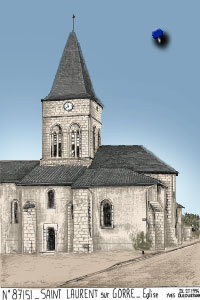Dupuis and Richer.
François Dupuis.

In his marriage record of 1670, François declared he was the son of François Dupuis and Marguerite Resneau. Born in Saint-Laurent-sur-Gorre, about 20 miles west of Limoges in Limousin, estimates of his birth year range between 1634 and 1637. The village was home to a few mills. Ponds and la Gorre river offered plenty of fresh fish to the inland community. A Romanesque church and two chateâus adorned the landscape.
Men were recruited in France by those with an interest in the sustainability of the colony. François likely came to Québec under a contract as an engagé necessitating he work for a specific period of time. Many workers returned to France when their contract was complete, but many others chose to remain. Typically the terms of service were for three years and involved any manner of general labor from building, working in the fields or assisting with whatever trade the contract holder was involved. After satisfying his obligation, it may have taken another year or so to establish oneself well enough to marry making it likely François immigrated sometime before 1667.
Georgette Richer.
Our ancestor Georgette Richer was born and baptized in Saint-Ursin church on 30 October 1644 in the village of Chailly-sur-Armançon in Bourgogne, France. Her mother was not named in the birth record, though her father Jean Richard, and Louys Richard parrain and Georgette Chalon marraine were. She had an older brother named Bastien who was born on 20 October 1642. In her marriage record her parents are said to be Jean Richer and Liénarde Bornay.
Georgette was 26 when she sailed to Québec aboard La Nouvelle-France. Her shipmates included our ancestors Anne Lagou and Marguerite Raisin, and about 125 other filles du roi sponsored by the King of France to bolster settlements in the New World. Under the auspices of the recently reappointed Intendant Jean Talon 100 engagés, 100 sailors and 6 companies of 50 men rounded out the passenger list. The men were sent to secure the fishing at l'Île Percée. Talon supported aggressive measures to insure the success of the colony. He sought to bolster Acadia to build a stronger border with New England, introduced the cultivation of hemp for fiber to make clothing locally and built breweries to augment the sale of wheat.
Their departure was delayed due to bad weather, and on 5 May 1670 the King was reassured the settlers would be transported to Canada, Acadia, Plaisance and Isles d' Amérique. The women had little to expect in the way of privacy for many weeks during the voyage; a canvas hung from the rafters was often the only barrier from the men. Trips topside were limited, especially in inclement weather.
Upon their arrival in Québec on 31 July 1670, the women were escorted to the homes of their sponsors. There they would be introduced to eligible young men in the colony to marry. Of Georgette's shipmates, Anne Lagou married a carpenter in Saint-Augustine-des-Maure and Marguerite Raisin went on to marry a soldier in Chambly.
- Jetté, René, Dictionnaire généalogique des familles du Quebec des origines à 1730, Montreal: Les Presses de l'Universite de Montreal, 1983
- https://www.historymuseum.ca/virtual-museum-of-new-france/population/immigration/ 33,000 men came/10,000 stayed
- Fichier Origine RICHER / RICHARD, Georgette 370072
- https://www.migrations.fr/NAVIRES_LAROCHELLE/lanouvellefrance1670.htm(26 Feb 2016) and https://www.migrations.fr/700fillesroy.htm (29 July 2010)
- https://en.wikipedia.org/wiki/Jean_Talon
